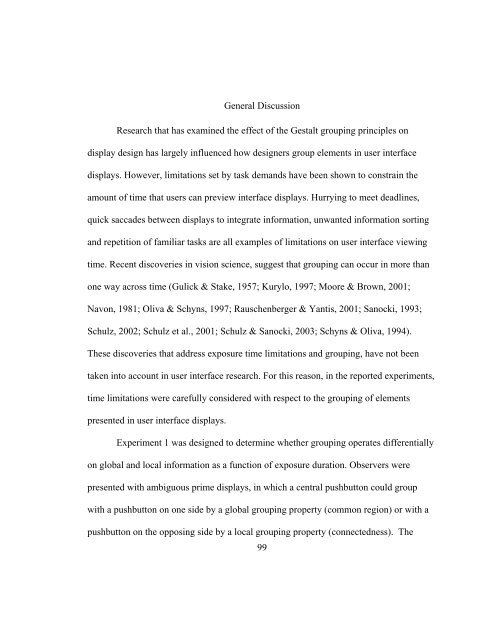The Use of Iambic Pentameter in the
The Use of Iambic Pentameter in the
The Use of Iambic Pentameter in the
You also want an ePaper? Increase the reach of your titles
YUMPU automatically turns print PDFs into web optimized ePapers that Google loves.
General Discussion<br />
Research that has exam<strong>in</strong>ed <strong>the</strong> effect <strong>of</strong> <strong>the</strong> Gestalt group<strong>in</strong>g pr<strong>in</strong>ciples on<br />
display design has largely <strong>in</strong>fluenced how designers group elements <strong>in</strong> user <strong>in</strong>terface<br />
displays. However, limitations set by task demands have been shown to constra<strong>in</strong> <strong>the</strong><br />
amount <strong>of</strong> time that users can preview <strong>in</strong>terface displays. Hurry<strong>in</strong>g to meet deadl<strong>in</strong>es,<br />
quick saccades between displays to <strong>in</strong>tegrate <strong>in</strong>formation, unwanted <strong>in</strong>formation sort<strong>in</strong>g<br />
and repetition <strong>of</strong> familiar tasks are all examples <strong>of</strong> limitations on user <strong>in</strong>terface view<strong>in</strong>g<br />
time. Recent discoveries <strong>in</strong> vision science, suggest that group<strong>in</strong>g can occur <strong>in</strong> more than<br />
one way across time (Gulick & Stake, 1957; Kurylo, 1997; Moore & Brown, 2001;<br />
Navon, 1981; Oliva & Schyns, 1997; Rauschenberger & Yantis, 2001; Sanocki, 1993;<br />
Schulz, 2002; Schulz et al., 2001; Schulz & Sanocki, 2003; Schyns & Oliva, 1994).<br />
<strong>The</strong>se discoveries that address exposure time limitations and group<strong>in</strong>g, have not been<br />
taken <strong>in</strong>to account <strong>in</strong> user <strong>in</strong>terface research. For this reason, <strong>in</strong> <strong>the</strong> reported experiments,<br />
time limitations were carefully considered with respect to <strong>the</strong> group<strong>in</strong>g <strong>of</strong> elements<br />
presented <strong>in</strong> user <strong>in</strong>terface displays.<br />
Experiment 1 was designed to determ<strong>in</strong>e whe<strong>the</strong>r group<strong>in</strong>g operates differentially<br />
on global and local <strong>in</strong>formation as a function <strong>of</strong> exposure duration. Observers were<br />
presented with ambiguous prime displays, <strong>in</strong> which a central pushbutton could group<br />
with a pushbutton on one side by a global group<strong>in</strong>g property (common region) or with a<br />
pushbutton on <strong>the</strong> oppos<strong>in</strong>g side by a local group<strong>in</strong>g property (connectedness). <strong>The</strong><br />
99

















